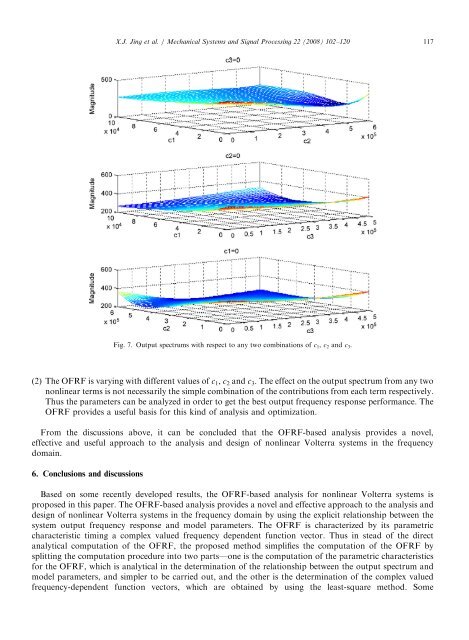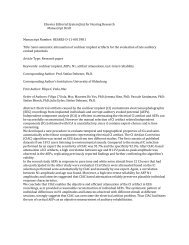Output frequency response function-based analysis for nonlinear ...
Output frequency response function-based analysis for nonlinear ...
Output frequency response function-based analysis for nonlinear ...
You also want an ePaper? Increase the reach of your titles
YUMPU automatically turns print PDFs into web optimized ePapers that Google loves.
(2) The OFRF is varying with different values of c1, c2 and c3. The effect on the output spectrum from any two<br />
<strong>nonlinear</strong> terms is not necessarily the simple combination of the contributions from each term respectively.<br />
Thus the parameters can be analyzed in order to get the best output <strong>frequency</strong> <strong>response</strong> per<strong>for</strong>mance. The<br />
OFRF provides a useful basis <strong>for</strong> this kind of <strong>analysis</strong> and optimization.<br />
From the discussions above, it can be concluded that the OFRF-<strong>based</strong> <strong>analysis</strong> provides a novel,<br />
effective and useful approach to the <strong>analysis</strong> and design of <strong>nonlinear</strong> Volterra systems in the <strong>frequency</strong><br />
domain.<br />
6. Conclusions and discussions<br />
ARTICLE IN PRESS<br />
X.J. Jing et al. / Mechanical Systems and Signal Processing 22 (2008) 102–120 117<br />
Fig. 7. <strong>Output</strong> spectrums with respect to any two combinations of c1, c2 and c3.<br />
Based on some recently developed results, the OFRF-<strong>based</strong> <strong>analysis</strong> <strong>for</strong> <strong>nonlinear</strong> Volterra systems is<br />
proposed in this paper. The OFRF-<strong>based</strong> <strong>analysis</strong> provides a novel and effective approach to the <strong>analysis</strong> and<br />
design of <strong>nonlinear</strong> Volterra systems in the <strong>frequency</strong> domain by using the explicit relationship between the<br />
system output <strong>frequency</strong> <strong>response</strong> and model parameters. The OFRF is characterized by its parametric<br />
characteristic timing a complex valued <strong>frequency</strong> dependent <strong>function</strong> vector. Thus in stead of the direct<br />
analytical computation of the OFRF, the proposed method simplifies the computation of the OFRF by<br />
splitting the computation procedure into two parts—one is the computation of the parametric characteristics<br />
<strong>for</strong> the OFRF, which is analytical in the determination of the relationship between the output spectrum and<br />
model parameters, and simpler to be carried out, and the other is the determination of the complex valued<br />
<strong>frequency</strong>-dependent <strong>function</strong> vectors, which are obtained by using the least-square method. Some

















